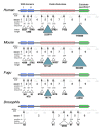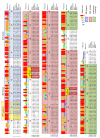Molecular Biology of the WWOX Gene That Spans Chromosomal Fragile Site FRA16D
- PMID: 34210081
- PMCID: PMC8305172
- DOI: 10.3390/cells10071637
Molecular Biology of the WWOX Gene That Spans Chromosomal Fragile Site FRA16D
Abstract
It is now more than 20 years since the FRA16D common chromosomal fragile site was characterised and the WWOX gene spanning this site was identified. In this time, much information has been discovered about its contribution to disease; however, the normal biological role of WWOX is not yet clear. Experiments leading to the identification of the WWOX gene are recounted, revealing enigmatic relationships between the fragile site, its gene and the encoded protein. We also highlight research mainly using the genetically tractable model organism Drosophila melanogaster that has shed light on the integral role of WWOX in metabolism. In addition to this role, there are some particularly outstanding questions that remain regarding WWOX, its gene and its chromosomal location. This review, therefore, also aims to highlight two unanswered questions. Firstly, what is the biological relationship between the WWOX gene and the FRA16D common chromosomal fragile site that is located within one of its very large introns? Secondly, what is the actual substrate and product of the WWOX enzyme activity? It is likely that understanding the normal role of WWOX and its relationship to chromosomal fragility are necessary in order to understand how the perturbation of these normal roles results in disease.
Keywords: FRA16D; common chromosomal fragile sites; evolutionary conservation; intragenic homozygous deletion; megabase gene; oxido-reductase specificity.
Conflict of interest statement
The authors declare no conflict of interest.
Figures


References
-
- Ohta M., Inoue H., Cotticelli M.G., Kastury K., Baffa R., Palazzo J., Siprashvilli Z., Mori M., McCue P., Druck T., et al. The FHIT gene, spanning the chromosome 3p14.2 fragile site and renal carcinoma-associated t(3;8) breakpoint, is abnormal in digestive tract cancers. Cell. 1996;84:587–597. doi: 10.1016/S0092-8674(00)81034-X. - DOI - PubMed
Publication types
MeSH terms
Substances
Grants and funding
LinkOut - more resources
Full Text Sources
Molecular Biology Databases

